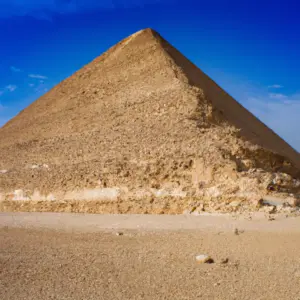
Pyramid of Merikare
The Pyramid of Merikare, also known as the Lahun Pyramid, is an ancient Egyptian structure located in the Faiyum region, approximately 100 kilometers southwest of Cairo. This pyramid dates back to the 12th Dynasty during the Second Intermediate Period, around 1800-1780 BCE. It was built for Pharaoh Merikare, who was the last known ruler of this dynasty and the son of Pharaoh Senusret III. The pyramid is an important historical site that provides valuable insights into the political, cultural, and architectural aspects of ancient Egypt.
Merikare’s reign was marked by a series of challenges, including internal conflicts and the rise of the Hyksos, a foreign group that invaded Egypt and established their rule in the northern part of the country. These circumstances led to the fragmentation of the Egyptian state, which eventually resulted in the emergence of the 13th Dynasty in Thebes, in the south. Despite these difficulties, Merikare’s rule was characterized by his efforts to restore order and stability in Egypt.
The Pyramid of Merikare is a step pyramid, which is a transitional form between the earlier, massive, and nearly featureless mastaba tombs and the true pyramids that followed later in the Middle Kingdom. This architectural style represents the evolution of the royal tombs in ancient Egypt, reflecting the changing beliefs and technological advancements of the time. The step pyramid at Lahun consists of six stacked rectangular layers, with each layer being slightly smaller than the one below it. The original height of the pyramid was approximately 60 meters, but today only a portion of the structure remains, standing at around 25 meters.
The construction of the pyramid was overseen by the royal architect and vizier, Kheruef, who left behind a series of inscriptions detailing the building process and his daily tasks. These inscriptions provide a unique glimpse into the organization and management of a large-scale construction project in ancient Egypt. Kheruef’s records also reveal the involvement of skilled workers, including masons, carpenters, and laborers, who were responsible for quarrying and transporting the massive limestone blocks used in the pyramid’s construction.
In addition to the pyramid itself, the site at Lahun also features a mortuary temple, a valley temple, and a workers’ village. The mortuary temple, dedicated to the worship of Merikare and the sun god, Ra, was designed to ensure the pharaoh’s successful journey through the afterlife. The temple complex includes several chapels, courtyards, and offering tables, as well as a large statue of Merikare, which is now on display at the Egyptian Museum in Cairo.
The valley temple, located near the eastern bank of the Bahr Yussef canal, was responsible for the purification and preparation of the pharaoh’s mummy and his funerary equipment before they were transported to the pyramid. The remains of a workers’ village have also been discovered near the site, providing valuable information about the living conditions and social structure of the laborers who built the pyramid.
The Pyramid of Merikare has been the subject of numerous archaeological excavations and studies since its initial discovery in the late 19th century. The most significant of these was conducted by the British archaeologist, Sir Flinders Petrie, in 1888-1889. Petrie’s work revealed the architectural plan of the pyramid, as well as a wealth of artifacts, including pottery, tools, and inscriptions that shed light on the daily life and beliefs of the ancient Egyptians during this period.
In conclusion,
the Pyramid of Merikare is a fascinating monument that offers a unique insight into the political, architectural, and cultural aspects of ancient Egypt during the Second Intermediate Period. Its construction and the surrounding structures reflect the evolution of royal tombs and the society’s beliefs about the afterlife. The ongoing research and excavations at the site continue to contribute to our understanding of this important era in Egyptian history.